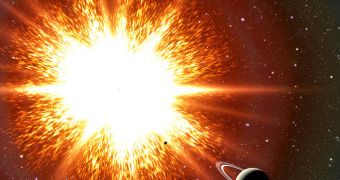Astronomers have just discovered that the Milky Way may be laden with ticking time bombs, old stars that are only kept going by the fact that they spin at high speeds. Once they drop below a certain threshold, there is a significant risk that they could blow up, causing massive destruction all around.
Not all stars pose this threat, experts say, but some do. This is what makes them so hard to discover, and to gage the extent of the danger. On the outside, these celestial bodies may appear normal, and only in-depth studies may reveal that they are in fact rigged to blow.
What makes them so dangerous is the fact that they go out in massive supernova explosions once they sow down their rotations. Such events are so bright that they can briefly outshine entire galaxy, spreading material and the seeds of nebulae over thousands of light-years.
The cores of these massive objects collapse into either a neutron star, a pulsar, a magnetar or a black hole, which then goes on to grow by accreting mass from its surroundings. All in all, the potential for destruction that supernovae have is tremendous.
“We haven't found one of these 'time bomb' stars yet in the Milky Way, but this research suggests that we've been looking for the wrong signs. Our work points to a new way of searching for supernova precursors,” Rosanne Di Stefano says.
The expert holds an appointment as an astrophysicist at the Harvard-Smithsonian Center for Astrophysics (CfA). She and her colleagues led the new investigation, which was focused on studying one of the two main forms of supernova, Type Ia events.
These events are triggered when white dwarf stars, usually in binary systems, become destabilized due to the fact that they accrete mass from their companions. The extra mass pushes them beyond their equilibrium limit, forcing a huge thermonuclear reaction to ensue.
Though most astronomers agree with this theory, evidence that this actually happens is scarce. Small amounts of hydrogen and helium gas should be detected near the explosion, but no instrument has thus far identified such chemicals.
But the conundrum can be solved by accepting that a spin-up/spin-down process occurs on the white dwarf. As the star accretes more mass, it can go beyond the 1.4-solar-masses limit that keeps such objects stable. This threshold is called the Chandrasekhar limit.
If the white dwarfs accrete mass and increase their angular momentum, they can remain stable even if they become super-Chandrasekhar-mass stars. But slowing down would immediately throw the object into disarray, forcing a massive explosion.
What the CfA team is proposing is that high angular momentum is what keeps many white dwarfs in binary systems from blowing up right now. Instances of such systems have thus far been observed throughout the Milky Way, and may be common throughout the Universe as well.
“Our work is new because we show that spin-up and spin-down of the white dwarf have important consequences. Astronomers therefore must take angular momentum of accreting white dwarfs seriously, even though it's very difficult science,” Di Stefano explains.
He adds that the rapid spin could delay the explosion of a super-Chandrasekhar-mass white dwarf by as much as 1 billion years. After Sun-sized stars turn into these hydrogen-burning objects, they can live for up to 3 billion years more.
The main implication of the new work is that dozens of pre-explosion systems are located within a few thousand light-years of Earth, in all directions. This number is based on statistics which show that around 3 Type Ia supernova events occur in the Milky Way every 1,000 years or so.
“We don't know of any super-Chandrasekhar-mass white dwarfs in the Milky Way yet, but we're looking forward to hunting them out,” Radboud University Nijmegen expert and study coauthor Rasmus Voss explains.
Experts from the Smithsonian Astrophysical Observatory, the Harvard College Observatorym, RUN and the Universiteit Utrecht were involved in this research. The work is published in the September 1 issue of the Astrophysical Journal Letters.

 14 DAY TRIAL //
14 DAY TRIAL //